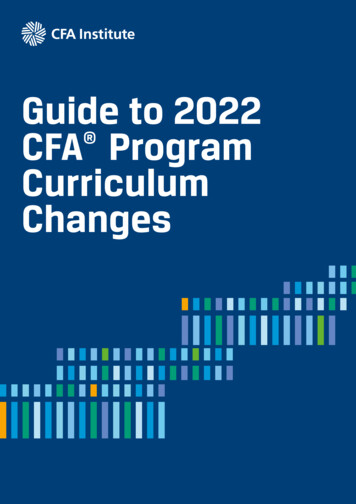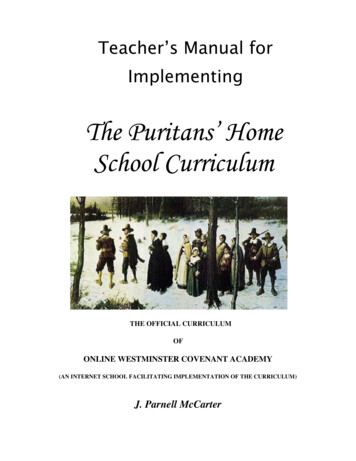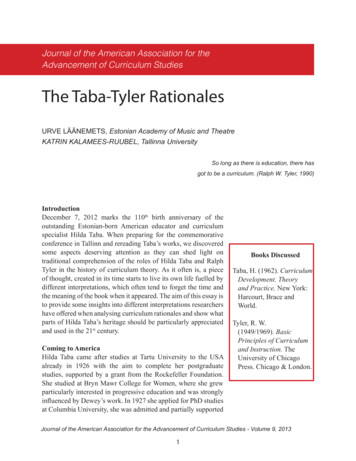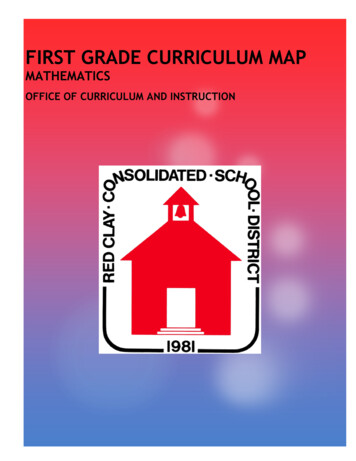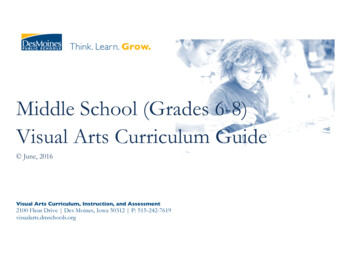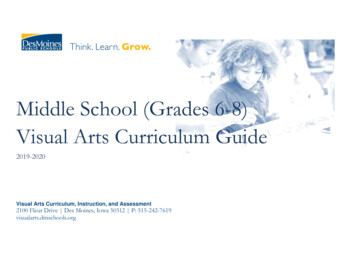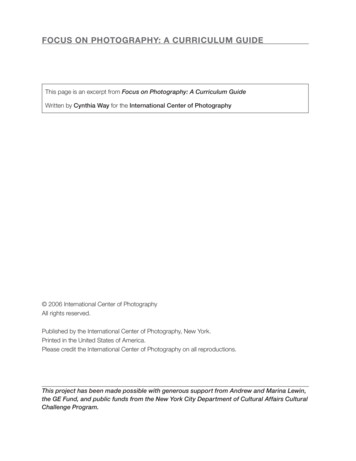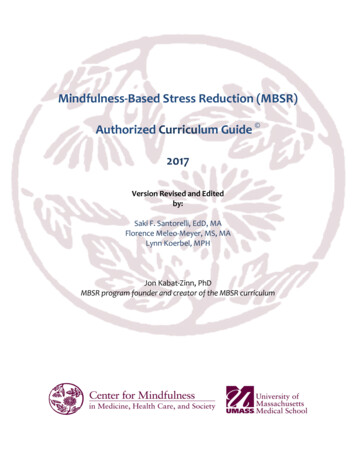
Transcription
Mindfulness-Based Stress Reduction (MBSR)Authorized Curriculum Guide 2017Version Revised and Editedby:Saki F. Santorelli, EdD, MAFlorence Meleo-Meyer, MS, MALynn Koerbel, MPHJon Kabat-Zinn, PhDMBSR program founder and creator of the MBSR curriculum
The Mindfulness-Based Stress Reduction authorized curriculum guide is the property of the University ofMassachusetts Medical School, Center for Mindfulness in Medicine, Health Care, and Society and maynot be copied, distributed, or transferred to any individual or any organization without written permission.
Center for Mindfulness in Medicine, Health Care, and Society (CFM)University of Massachusetts Medical SchoolMindfulness-Based Stress Reduction (MBSR)Authorized Curriculum Guide 2017ACKNOWLEDGEMENTSWe offer a deep bow of gratitude to our colleagues who have shepherded, with greatcare and attention, the MBSR program curriculum into mainstream medicine and healthcare since 1979 Jon Kabat-Zinn, PhDMBSR program founder and original curriculum writerMelissa Blacker, MAMajor editorial contributions to multiplerevisions of the MBSR curriculumContributors to this 2017 version include:Gwénola Herbette, PhDCarl Fulwiler, MD, PhDPlease direct all correspondence regarding the Authorized Curriculum Guide toLynn Koerbel, MPH: Lynn.koerbel@umassmed.edu
Center for Mindfulness in Medicine, Health Care, and Society (CFM)University of Massachusetts Medical SchoolMindfulness-Based Stress Reduction (MBSR)Authorized Curriculum Guide 2017Table of ContentsMBSR Course Overview 1Orientation Session Overview .3Orientation Session Logistical Details .5Class One .9Class Two .12Class Three .15Class Four .18Class Five .21Class Six .25All-Day Class 29Class Seven .33Class Eight .36Notes on the Curriculum .39Appendix: Conducting Orientation Sessions at the UMass Center for Mindfulness 41
Center for Mindfulness in Medicine, Health Care, and Society (CFM)University of Massachusetts Medical SchoolMindfulness-Based Stress Reduction (MBSR)Authorized Curriculum Guide 2017OverviewAs the place of origin of Mindfulness-Based Stress Reduction (MBSR), the University of MassachusettsCenter for Mindfulness has, since 1979, conceptualized, developed, implemented and researched MBSRin the form of an 8-week, 10-session course comprised of 31 hours of direct instruction.This 2017 version of MBSR Curriculum Guide is based upon our cumulative experience totaling morethan one million hours of clinical care, more than 24,000 MBSR program completers, referred by morethan 7,000 physicians, hundreds of other health care professionals, and through self-referral. In ourview, maintaining the fidelity and integrity of MBSR as detailed in this Curriculum Guide will help insurethe clinical efficacy, scientific validity, and educational rigor of this approach.Adherence to the theoretical constructs and core elements of MBSR as described in this CurriculumGuide are based upon clinical experience and scientific investigations. As these investigations proceedand new discoveries are made, we welcome and are prepared to alter the MBSR curriculum.Currently, there are a wide-range of mindfulness-based programs that have developed out of the basicstructure and format of MBSR. We applaud these adaptations and experiments while strongly urgingour colleagues to call what they do MBSR only if they adhere to the structure and standards describedherein. Without such adherence, the veracity of MBSR will be diminished and the scientific resultsincreasingly suspect.At its core, MBSR is based on systematic and intensive training in mindfulness meditation and mindfulhatha yoga. The curriculum, originally developed by Jon Kabat-Zinn, Ph.D., is an expression andreflection of this core principle. Therefore, it is termed “mindfulness-based.” In continualdevelopment in the Mindfulness-Based Stress Reduction Clinic at University of Massachusetts MedicalSchool, the curriculum is designed to guide MBSR program participants in the “how” of learning topractice, integrate, and apply mindfulness in their everyday lives. The primary intention of the MBSRcurriculum is to create a structured pathway to relieve suffering and increase wellbeing for peoplefacing a host of challenges arising from a wide range of medical and psychological conditions and thedemands and stressors inherent in the everday lives of human beings.Embedded within the context of Mind-Body and Participatory Medicine, the MBSR curriculum focuseson the experiential cultivation of both “formal” and “informal” mindfulness practice as a means offamiliarizing one self with awareness itself (mindfulness). The recognition of an innate, ever-presentawareness is the foundation for the development of positive health behaviors, psychological and1Center for Mindfulness in Medicine, Health Care, and Society, University of Massachusetts Medical School
emotional resilience, and an overarching sense of wellbeing that can be effectively cultivated andrelied upon across the adult life span.MBSR clinical and basic science research and our experience at the Center for Mindfulness at theUniversity of Massachusetts Medical School strongly supports the efficacy of MBSR as an effectiveclinical approach that can be utilized by participants far beyond completion of the program.2Center for Mindfulness in Medicine, Health Care, and Society, University of Massachusetts Medical School
Orientation Session: Overview(For an in-depth description of the Orientation Session as followed at UMass Medical School see Appendix A)OverviewThe main intentions of the Orientation include:v Familiarizing potential participants with what MBSR is and is notv Providing participants with an experience of mindfulness in anatmosphere of trust and non-judgmental awareness and exchangev Educating participants about program proceduresv Assessing how participants interact in the group setting to determinewhether the program is a good matchv Meeting with each participant individually for a brief screening interviewv Eliciting a commitment from participants to engage in activeparticipation in the program, which includes weekly class attendanceand a minimum of 45 minutes to one hour of formal home practice aswell as informal practice throughout the lPracticeTypical ClassSequence1:00 - 1:25 hours to cover all components in large groupShort Yoga sequenceSitting Meditation – Awareness of BreathFollowing the Group Orientation Session, if participants are waiting their turn foran individual interview, an invitation can be offered to consider becomingaware—for brief moments—of the environment, bodily sensations, feelings ofimpatience or boredom, excitement etc.v Overview of orientationv Brief history of MBSR and the Stress Reduction Clinic (SRC) (adapt forlocal venue as needed)v Introduce Mindfulnessv Brief practice (yoga, short AOB) (Practice is offered here just as it is donein the MBSR class, including guidance for taking care, self-assessing beforetaking part in any movement, and exploring one’s current limits withoutpushing oneself beyond them)v Brief sharing of the immediate mindfulness practice experience withOrientation Session participants3Center for Mindfulness in Medicine, Health Care, and Society, University of Massachusetts Medical School
Typical ClassSequence(cont)v Class Logistics: Times, dates (including the All-Day class), the importanceof attending each class and the commitment to daily practicev Class Content: Experiential learning of formal and informal practices;recordings and home practice; class topics: Perception, stressphysiology, stress reactivity and responding, communicationv Guidelines for Participation: Commitment, engagement with practice,no need to “believe” anything as a pre-requisite for participation,attentiveness to one’s experience as the primary “data.” Note that whileparticipants are not required to speak in class, class dialogue in smallgroups and the larger group is a meaningful part of class time.v Risks & Benefits:Risks – Physical, emotional, time, social; also note possibleexclusions or areas to talk more with instructor during interview:Addiction, early recovery, untreated psychosis, acute depression,suicidality, PTSD, Social Anxiety, recent loss. These circumstances orconditions do not rule out the possibility of being in the class, but it isessential to share with the teacher during the interview these oranything that feels important to share. During the interview theteacher can offer suggestions for support and make recommenddations for the most successful outcomes for participation in theMBSR class ( Please refer to Appendix A for detailed information andprocedures regarding candidate referrals to appropriate medical andpsychological professionals and health emergency intervention.)Benefits – Better coping, evidence-based, dependent on consistentpractice, capacity to better care for self, no guaranteesv Invite additional questionsv Individual InterviewCenter for Mindfulness in Medicine, Health Care, and Society, University of Massachusetts Medical School4
MBSR Orientation Session Logistical DetailsLogistics of the MBSR Course:Below are detailed logistics that are included in the CFM Orientation Sessions. Some logistics areadaptable depending on the venue and whether there is one class or several being offered in a giventimeframe; options are indicated below. Please see Standards of Practice for more information onprogrammatic elements required to be considered “MBSR.”v The course meets every week for 8 weeks, either in the morning or evening, for 2.5 to 3.5hours (adapt times for local venue).v There is an “All-day” class (a silent retreat day) between the 6th and 7th week on a weekendday, from 8:45 a.m.– 4:30 p.m. (It is also possible to hold the All-day class between the 5th and6th week if schedules demand).v Formal and informal practices: In each class participants will learn about and practicedifferent forms of mindfulness including formal practices of yoga, sitting meditation, bodyscan, and walking meditation as well as informal practices such as mindful eating, speakingand listening, and mindfulness of daily activities.v Topics covered in class: Participants will learn about stress, and explore the habitual,automatic behavioral, physical, emotional and cognitive patterns as well as investigate, indetail, more effective and skillful responses to the challenges and demands of everyday life.In parallel, we’ll also be exploring what it means to take care of ourselves and flourish, howto relate to ourselves and others more effectively and what it might be like to nourishbehaviors and activities that express our innate capacity for wellbeing.v In each class there will be periods of formal mindfulness practice, small and large groupdiscussions and talks, as well as practices and exercises related to that week’s topics.v Recordings for Home Practice: Participants will receive CDs or Mp3 downloads with guidedmeditation and yoga practices and a home practice manual, weekly handouts or email/onlineinformation with each week’s formal and informal practice assignments.v Class size: There will be approximately people in each class. (Class sizes may varyfrom as few as 15 and as many as 40 depending on the venue, community, etc. See Standards ofPractice for suggested class size.)v What to wear/bring: Comfortable clothing, loose at the waist that allows for unconstructedbreathing, supports practice. There are no scheduled breaks during class; take care ofpersonal needs as required (this includes bathroom, food, water, medications). Encourageeating lightly before class and avoid having food in the classroom, although if food is neededfor medical reasons, individuals should be accommodated. Request refraining from use ofscented personal care products (this may include detergents) due to others’ sensitivity.v Daily home practice consists of 40-45 minutes of recorded formal practice in addition toother exercises, activities, or practice not requiring a recording. Total daily practice time is5Center for Mindfulness in Medicine, Health Care, and Society, University of Massachusetts Medical School
60 minutes or more. Encourage participants to consider how they will set aside time for dailypractice since this is an essential component to the program.v Acknowledge stressfulness of participation in MBSR. This includes time commitment andother possible challenges.v Attendance: Attendance at all 9 classes, including the all-day class is emphasized. If aparticipant misses a class, there may be possibilities for making up the class that week onanother day if multiple classes are held at the site (dependent on venue). If someone knowsthey will miss 2 or more classes, encourage participation in a different cycle. If, during thecourse, a participant misses 3 or more classes, they are encouraged to drop out and take theentire program again in another cycle when they are able to make the time commitment.Emphasize the importance of arriving on time. Remind participants to call the teacher if theyare unable to attend class, need to make up in another class, or know you will be late forclass.v Weather policies: Explain any inclement weather policy.v Informed consent - Class audio and video recordings for teacher development (ifapplicable; dependent on venue): Explain the nature and use of video and audio recording ofeach class. Inform participants recordings are used solely to support ongoing teacherdevelopment and competency assessment. Have participants sign Informed Consentdocument before Orientation or the first class.Explain the risks and benefits of the program. (Note: it is only after these have been explained thatthe participant can sign the informed consent agreement.)Physical risks (If a brief yoga/movement practice is offered during the Orientation Session, as issuggested, these introductory points of guidance should be included during that movementexperience and then reviewed in more depth here):v The primary physical risk is connected to practicing mindful yoga.v Knowing oneself and taking care of oneself is at the core of mindfulness.v If a participant hears guidance that they know is not appropriate for their body or condition,or if anything causes pain, the correct action is to disregard the teacher and either modifythe pose/movement, rest and imagine doing the pose/movement, or notice andacknowledge any thoughts or emotions that may be arising in the experience of not doingthe pose/movement.v Focus is on exploring one’s physical limits, by going to the edge of those limits, but notbeyond. This exploration is done slowly and with sensitivity, guided by the teacher.v Being aware of the body from moment to moment and in everyday situations is an essentialaspect of MBSR. The formal yoga sequences are a structured way of developing greaterbody awareness, and as such, are awareness practices rather than practices to develop aspecific form or alignment that is often emphasized in other types of yoga.6Center for Mindfulness in Medicine, Health Care, and Society, University of Massachusetts Medical School
v The teacher offers modifications or adaptations to poses/movements to meet the variety ofcapacities in the class (as was demonstrated in the brief practice guided during Orientationsession).v Participants with physical conditions or limitations should ask their healthcare provider toreview the postures in the practice manual, and to suggest only those postures that aresuitable.Emotional risks:v Feelings of sadness, anger, or fear, could seem or become stronger as practice develops,since paying attention in a conscious way—perhaps for the first time—can highlightemotions.v A history of trauma, abuse, significant recent loss or major life changes, or addiction tosubstances may heighten emotional reactions. Please speak with the teacher if this occurs,and together you can determine the best course of action (i.e., modifying practice, droppingthe course, waiting for another time when acute symptoms may be less).v Participants may make discoveries about themselves that they may not like.v Participants may be challenged and find themselves facing the unknown.v Experiential learning is often non-linear; participants’ symptoms can sometimes worsen,particularly in the early weeks of the program. Even with regular practice, participants mayfeel like “nothing is happening.” This is normal and a typical aspect of any learning process.Participants are encouraged to speak to their teacher with any concerns.Other people in your life:v It may be a challenge to set aside the space and time to do this practice; requestingassistance from from family, friends and/or co-workers may be supportive.v Participants may experience changes in reactivity, behavior and communication, and family,friends and/or co-workers may be uncomfortable with these new behaviors or attitudes.v Participants may find that their relationships change as attention deepens and newbehaviors evolve.Time:v Finding time to make a new habit of mindfulness practice can be challenging: it’s normal tohave the idea that there is not enough time for practice. Participants often find, counterintuitively, that setting aside time for practice increases the sense of spaciousness in the restof the day.7Center for Mindfulness in Medicine, Health Care, and Society, University of Massachusetts Medical School
Benefits:v Increased awareness and concentrationv Discovering new ways to cope more effectively with existing conditions difficulties, pain orsufferingv Learning to take better care of oneselfv Many physical, psychological and emotional health benefits of MBSR have been reported inscientific literaturev We cannot guarantee or promise any particular results from participation in the MBSRcourse. Rather, emphasis is placed on the participant’s active engagement in the program.We encourage participants to assume the stance of a scientist investigating their area ofinterest: with openness and curiosity, suspension of judgement and a sense of healthyquestioning. It is more important for a participant to experience for themselves whatever ishappening, rather than for the teacherto tell them what may or may not happen as a resultof their participation in the course.Invite additional questions8Center for Mindfulness in Medicine, Health Care, and Society, University of Massachusetts Medical School
Class OneOverviewThemeThis 3-hour session includes a review of the approach and theestablishment of a learning contract with the participant/patient. Thetheoretical underpinnings of mindfulness within the context of MindBody and Participatory Medicine and the application of self-regulatoryskills related to the individual’s condition or referring diagnosis are alsoestablished. The participant/patient is experientially introduced to mindfuleating, some standing yoga stretches, mindfulness of breathing and thebody scan meditation. Home practice is assigned using the first guidedrecording (body scan meditation) as a means of beginning to learn tobecome familiar with mindful awareness of the body.From our point of view, as long as you are breathing, there is more rightwith you than wrong with you, no matter what challenges you are facing.Challenges and difficulties are workable. Mindful awareness, defined asthe awareness that arises from paying attention, on purpose, in thepresent moment, non-judgmentally, (Kabat-Zinn, J, Full CatastropheLiving, 1990, 2013) is fundamental to this approach since the presentmoment is the only time anyone ever has for perceiving, learning,growing and transforming.Building trust within the group and beginning to sense a community ;defining and applying mindfulness to our life experientially; opening andstarting to explore; acknowledging alternative perspectives; trusting thepossibility to see oneself with fresh eyes.Recommended Formal Practice – Approximately 1 hour (much depends on the size of theTimegroup and how much time is allotted for the body scan).AllocationsInformal Practice – Approximately 20-30 minutes (eating meditation)Group Discussion – 1 hour (depending on size of group and needs forgroup introductionsLogistics (attendance, announcements, home practice) – 30 minutesFormal Practice Opening Practice (brief, arriving)Body ScanStanding Yoga (It is recommended that a few poses from the StandingYoga sequence be introduced in classes 1, 2, 4 and 5, so that by Class 5,when participants/patients receive the Standing Yoga recording, allStanding Yoga postures will have have been introduced, eliminating theneed to do the sequence in its entirety in class 5)InformalPracticeEating Meditation9Center for Mindfulness in Medicine, Health Care, and Society, University of Massachusetts Medical School
Typical ClassSequence(continued)Welcome and brief introduction of program by the instructorOpening meditation: becoming attentive to and aware of thoughts,emotions, and sensations in the present moment (may also include whatis seen, heard, other senses)Class responses to opening meditation (can be just a few responses if it isa large class)Review definition of mindfulness, including entire time in class as anopportunity to practice moment-to-moment seamless awareness (notjust in the meditations)Review of guidelines for participation i.e.: Confidentiality, self-care,communication with instructor, no advice-giving, no fixing or rescuingothers, avoidance of scentied products, etc.Guided individual internal reflection: What has brought you here? Whatis your intention? What do you really want? (Option: small group or dyadsharing about guided reflection before going into large group.)Group go-around: Provide participants with the opportunity to introducethemselves, what they are here for, and their goals and expectations forthe program. The instructor may make instructive comments,observations, and welcoming remarks from time to time in response toindividuals. This is not a discussion; avoid cross-talk between participants,and teacher may inform the group that s/he may need to interrupt tokeep on time and maintain guidelines. Mindful listening and speaking maybe introduced here. Encourage everyone to speak—even if only to saytheir name. Also encourage those who may be attending for professionaltraining purposes (e.g. as the beginning of MBSR teacher training, forinstance, or in order to introduce mindfulness to their patients or clients)to drop beneath the professional role to the personal aspects of theirlives, to be authentic and willing to explore what is available for them,without pre-conceptions of this program solely as a training, but rather tosee their full partipation as an essential part of training.Yoga: Introduction to standing Mountain Pose and a few other standingposes (See recommendation under “Formal Practice” on previous page).Raisin-eating exercise: introduction to mindfulness meditation using theordinary act of eating, followed by a dialogue about the experience. Focuson direct sensory observation – what can be seen, felt, heard, smelled,tasted. Observing and then slowly eating one raisin, with guidance frominstructor, stopping for observations from participants. Bringing friendlycuriosity to this investigation, then eating a second raisin in silence.Instructor is attentive to observations that are deductions, opinions andtheories removed from the participant’s immediate experience. Groupdialogue can be an inquiry into what is directly experienced through thispractice. The instructor stays awake and alive to the recognition of past10Center for Mindfulness in Medicine, Health Care, and Society, University of Massachusetts Medical School
Typical ClassSequence(continued)experience influencing the present; the interconnection of the raisin to sun, soil, rain, energy of planting, harvesting, delivering the food, andthen becoming the energy of the body; relationship between hunger,satisfaction, emptiness, and fullness; and what shows up when presentfor the full act of eating. Not needing to necessarily bring these topicsforward, but allowing them to arise in the group.Abdominal breathing: Tie the moment-to-moment awareness of eatingexercise to experiencing the breath in the same way. Introduce variouscomfortable postures for lying down: corpse pose, astronaut pose, orsitting in chairs if necessary. Focus on the feeling of the abdomen risingand falling with the in-breath and the out-breath, mindfully “tasting” thebreath in the same way that the group tasted the raisin. Non-judgmentallyobserving one’s own breathing from moment to moment; and bringingone’s attention back to the breath and the present moment when themind wanders.Body Scan: From mindfulness of breathing, move into guided body scanwith people continuing to lie on floor or sitting in comfortable position.Finish with discussion of people’s experiences with the body scan andassign daily home practice. Give instructions for use of the 45-minuteBody Scan recording for home practice during Week One.Review home practice. End with short Awareness of Breath (AOB)meditation.Home Practice Body Scan recording 6 days this week Home Practice Manual: The 9 Dots Puzzle. Give instructions to workwith the puzzle and also be attentive to how you approach the puzzle. Eat one meal this week mindfully or at least a few bites during onemeal Optional informal practice (“small doses, many times”): Informallyand intentionally notice or cultivate moments of awareness duringthe day—tuning briefly into the breath, body, sounds, what can beseen, and thoughts and emotions—whatever is present, noticingwithout judgment; recognizing directly that you can deliberatelycultivate a continuity of awareness throughout your day as a way ofbeginning to access your innate resources for coping and meetinglive in ways that are less conditioned and more appropriate tosituations you are facing Optional informal practice: Informally practice some of the mindfulstretches you learned in class as a way to reconnect with the bodyand the present momentCenter for Mindfulness in Medicine, Health Care, and Society, University of Massachusetts Medical School11
Class TwoOverviewThemeThis 2.5 hour session includes one hour of experiential mindfulnesstraining and skill development, and one hour or more of focused dialogueand reflection on home practice and, thematically, on the role ofperception and conditioning in the appraisal and assessment of stress.The pivotal role of self-responsibility in the positive development of shortand long-term changes in health and health-enhancing behaviors isintroduced. Home practice is assigned with an emphasis on the regulardaily practice of the body scan for a second week, plus introduction ofshort periods of sitting meditation, and the application and integration ofmindfulness into the participant’s everyday life.Perception and creative responding: How you see things (or don’t seethem) will determine in large measure how you will react or respond tothem. This ties in with how people see their participation in the program;how they see their pain, their illness; the stress and pressures in their lives;the level of commitment they will bring to the program and to thepersonal discipline it requires. Make the connection to automatic habitualstress reactivity and recovery from acute stressors, and the principle that“It’s not the stressors per se, but how you handle them” that influencesthe short and long-term health effects they may have on your mind, bodyand overall sense of health and wellbeing.Recommended Formal Practice – 1 hourTimeGroup Discussion – 40 minutesAllocationsDidactic Presentation (nine dots) – 30 min including group discussionLogistics (attendance, announcements, home practice) – 20 minutesFormal Practice Opening meditationSitting MeditationStanding Yoga - a few postures (optional)Body Scan (45 minutes)AOB sitting meditation (introduction with postural guidance)InformalPracticeFor home practice: Mindfulness of routine activities: Brushing teeth,washing dishes, taking a shower, taking out garbage, shopping, readingto kids, eating (participant chooses one).Continue including some of the yoga poses into your day. Become awareof repetitive movements in ordinary activities, i.e. getting into and out ofthe car, preparing meals, bathing children, taking a walk, etc.12Center for Mindfulness in Medicine, Health Care, and Society, University of Massachusetts Medical School
Typical ClassSequenceStanding yogaGuided body scanSmall and/or large group work: Discussion of the body scan experienceboth in the session as well as home practice with particular attention tohow successful they were at making the time for it, problems andobstacles encountered (sleepiness, boredom, other), how they workedwith them or not, and what participants may be learning and/or seeingabout themselves from practicing the body scan.Establish the universality of the wandering mind and the notion ofworking with this recognition with curiosity, acceptance/acknowledgment and deliberate, repeated, re-focusing of attention;explicitly letting participants know that this deliberate re-directing ofmind and “coming back” is as much a part of the meditation practice asstaying on the object of attention; noting (without analysis) where themind goes and what is on one’s mind. Emphasize the importance ofdesisting from repressing and suppressing thoughts or feelings orforcing things to be a certain way. Best way to get somewhere is not totry to get anywhere, not even “relaxed.” The option is to “let be” or“let go.” This is a new way of lea
hatha yoga. The curriculum, originally developed by Jon Kabat-Zinn, Ph.D., is an expression and reflection of this core principle. Therefore, it is termed “mindfulness-based.” In continual development in the



